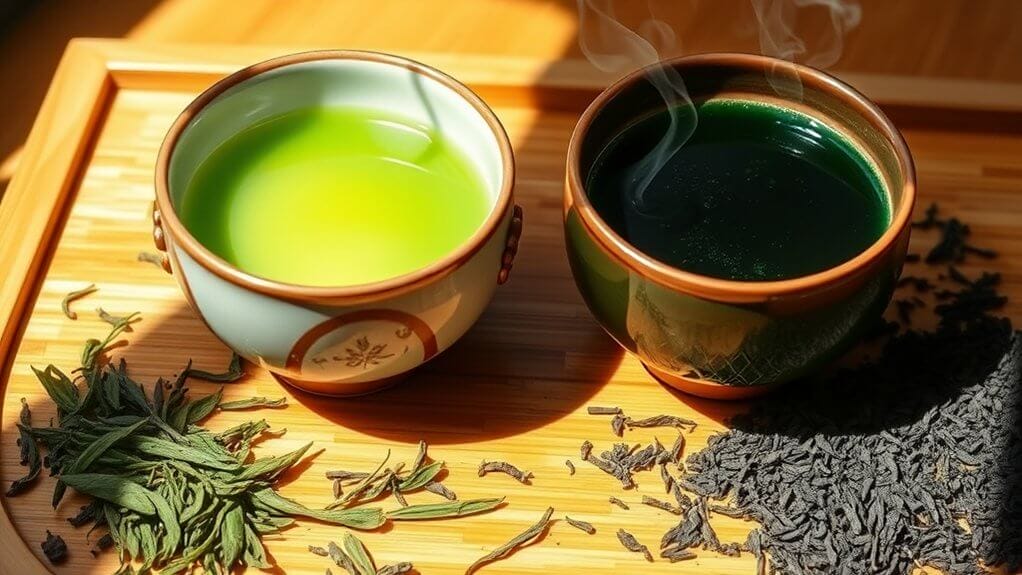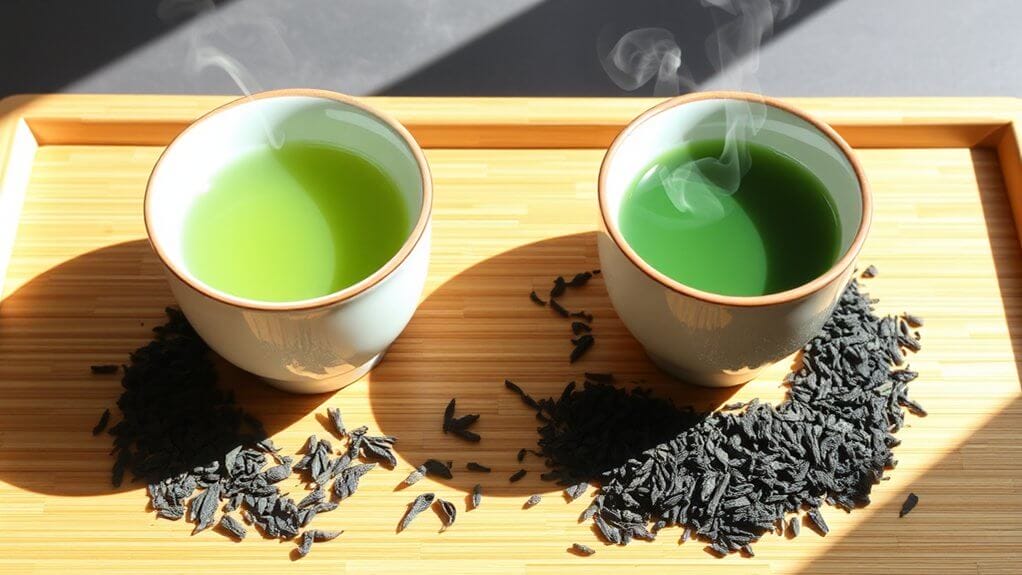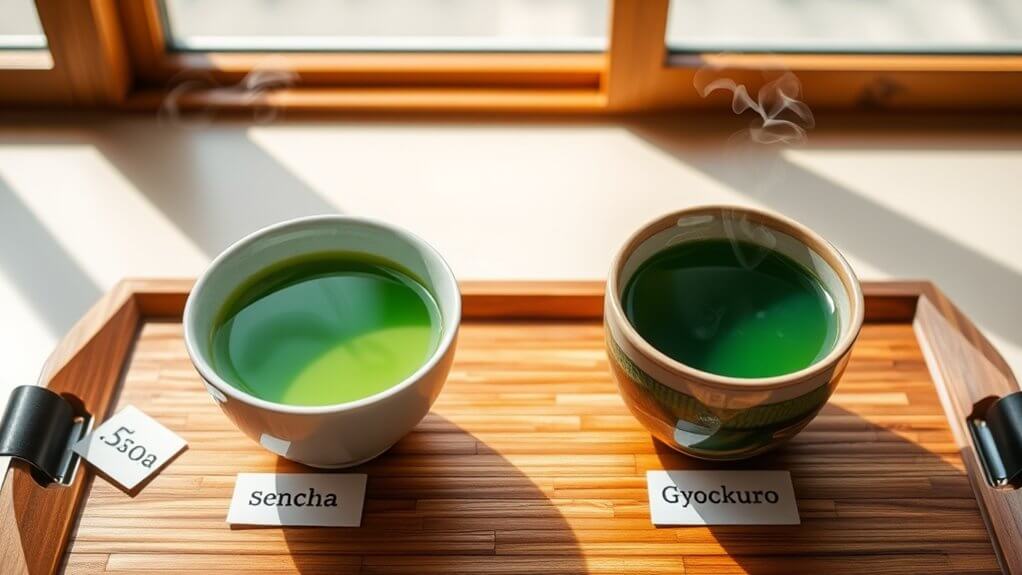Sencha and Gyokuro are Japan's most beloved green teas, each offering distinct experiences. Sencha's bright, grassy notes and affordable price point make it perfect for daily drinking, while Gyokuro's intense umami flavor and higher caffeine content justify its premium status. Sencha contains more antioxidants, but Gyokuro's unique shading process creates a richer L-theanine profile for enhanced mental clarity. The choice between these teas depends on one's taste preferences, budget, and desired benefits.
Key Points
- Sencha is ideal for daily consumption and budget-conscious tea drinkers, while Gyokuro suits special occasions and tea connoisseurs.
- Gyokuro offers intense umami and seaweed notes with higher caffeine content, while Sencha provides lighter, grassy, and citrusy flavors.
- Sencha contains more antioxidants due to higher catechin levels, while Gyokuro promotes better mental clarity through elevated theanine content.
- Price differences are significant, with Sencha offering quality at various affordable price points and Gyokuro commanding premium prices.
- Sencha requires minimal shading during production, while Gyokuro needs 21 days of shading, resulting in distinct flavor profiles.
The Origins and Legacy of Japan's Finest Green Teas

While China's tea culture spans millennia, Japan's green tea legacy began when Buddhist monks introduced tea during the Nara and Heian periods over a thousand years ago. Initially used as medicine, tea quickly gained cultural significance among the elite classes before spreading throughout Japanese society. The influential Zen priest Myouan Eisai documented tea's health and cultivation benefits in his groundbreaking work "Kissayojoki." Tea became particularly valued by the samurai class who relied on it as a hangover remedy.
The historical evolution of Japanese green tea reached a vital turning point in 1737 when Nagatani Soen revolutionized tea processing by developing the steaming and rolling method that created Sencha. Later, the development of Gyokuro marked another milestone in Japan's tea craftsmanship. The city of Uji emerged as a premier tea-growing region after monk Kohken planted tea trees there in 1271, cementing its reputation for producing exceptional teas. Today, both Sencha and Gyokuro represent the pinnacle of Japanese tea innovation and tradition. Sencha has become particularly widespread, now accounting for 70 percent of Japan's total green tea production.
Understanding the Production Process: Shading Techniques

Among the most distinctive aspects of Japanese tea production, shading techniques play an essential role in developing the unique flavors and characteristics of premium green teas. These shading methods directly influence tea classification, with varying periods of light reduction creating distinct profiles. Increasing chlorophyll content during shading gives dark jade tones to premium tea leaves.
The practice dates back to when farmers in the Uji region first developed shading structures using bamboo and straw in the mid-16th century. The process involves covering tea plants with materials ranging from black synthetic cloth to traditional rice straw, blocking 70-98% of sunlight. This reduction in photosynthesis lowers sugar and tannin levels while boosting umami-rich amino acids. The duration of shading determines whether the tea becomes sencha (minimal shading), kabusecha (1-2 weeks), or gyokuro (3+ weeks). This practice is primarily implemented during the Ichibancha season from April to May.
Each method, whether direct shading or frame-based approaches, creates specific flavor characteristics. Longer shading periods typically result in smoother, more savory teas with enhanced umami notes.
Caffeine Content and Energy Impact

The shading techniques that enhance Japanese green tea's flavor profiles also greatly influence their caffeine content and energy effects. Gyokuro, with its extended shading period, contains considerably higher caffeine levels, offering 20-30 mg per cup compared to Sencha's 15-20 mg. Studies show that tea plants increase their caffeine production during shading as a natural defense mechanism. The younger tea leaves used in both varieties contain higher caffeine levels since they need more protection from insects. While coffee typically delivers more intense stimulation, these teas offer a gentler energizing effect.
What's particularly interesting is how these teas deliver their energy boost. While both contain L-theanine, which promotes relaxation and focus, Gyokuro's higher caffeine content provides a more sustained energy release. The brewing method also affects caffeine extraction – hotter temperatures and longer steeping times pull out more caffeine.
For those seeking a powerful energy boost, Gyokuro's the clear winner. However, Sencha offers a more balanced option with moderate caffeine levels, making it ideal for daily consumption. Both teas deliver their energy differently than coffee, creating a smoother, more focused state.
Flavor Profiles and Tasting Notes

Japanese green tea connoisseurs often distinguish Gyokuro and Sencha through their distinct flavor signatures. Gyokuro delivers an intense umami profile with seaweed-like notes and a mellow taste, while Sencha offers a broader spectrum of flavors ranging from grassy to citrusy undertones. The significant taste variations stem from cover cultivation techniques used specifically for Gyokuro production. For additional variety, standard Sencha and Fukamushi provide different taste experiences based on steaming duration. Many tea enthusiasts find that high-grade sencha provides the ideal everyday drinking experience.
The aroma characteristics further set these teas apart. Gyokuro presents sweet, seaweed-like notes with its unique "mukimiko" scent, whereas Sencha exhibits more citrusy and floral elements. Texture differences are equally notable – Gyokuro possesses a dense, oily consistency that glides across the tongue, creating a long-lasting savory finish. In contrast, Sencha's lighter body produces a revitalizing, slightly drying sensation on the palate. These distinct qualities make each tea suitable for different drinking occasions and personal preferences.
Health Benefits and Wellness Properties

While both Sencha and Gyokuro offer substantial health benefits, their distinct production methods create notable differences in their wellness properties. Sencha demonstrates higher levels of catechins and total phenolic content, resulting in superior antioxidant benefits that support immune function and disease prevention. Its enhanced antioxidant activity makes it particularly effective for liver protection and fighting common illnesses.
Both teas excel in supporting weight management through increased fat oxidation and metabolic enhancement, especially when combined with exercise. They're also powerful allies for cognitive function, thanks to their unique combination of caffeine and theanine. Additionally, these teas provide gradual caffeine release throughout the day. However, Gyokuro's shading process reduces its catechin content compared to Sencha, though it maintains higher theanine levels, which promotes mental clarity and a sense of calm without jitters.
Making Your Choice: Price Points and Accessibility

When considering cost as a primary factor, Sencha emerges as the more practical choice for daily tea consumption, offering excellent value across various price points and quality levels. Pricing strategies among retailers reflect consumer demographics, with Gyokuro positioned as a premium product for special occasions and tea connoisseurs. Due to requiring 21 days of shading, Gyokuro's production demands significantly more time and resources than Sencha. The specialized shading process results in tea leaves rich in sweet umami flavor, making it highly sought after by tea enthusiasts.
- High-grade Sencha provides an accessible entry point into Japanese green tea culture, appealing to budget-conscious consumers
- Gyokuro's labor-intensive cultivation and specialized processing justify its higher market positioning
- Different consumer demographics drive the demand for both varieties, with daily drinkers favoring Sencha
- The price gap between these teas considerably influences purchasing patterns, especially for regular consumption
This price difference is clearly demonstrated in luxury tea sets where high-quality Gyokuro and Sencha combinations retail for ¥9,500 JPY. While both teas have their place in the market, Sencha's affordability and variety make it the go-to choice for most tea enthusiasts seeking quality without breaking the bank.
Conclusion
While some tea enthusiasts hesitate over the higher price of gyokuro, its intense umami flavor and concentrated health benefits make it worth the investment for special occasions. Meanwhile, sencha's versatility and approachable price point make it perfect for daily drinking. There's no wrong choice – both teas offer authentic Japanese craftsmanship and rich wellness properties. The best selection depends on individual taste preferences and lifestyle needs.




